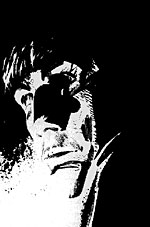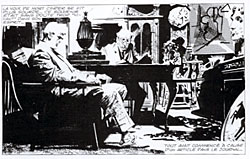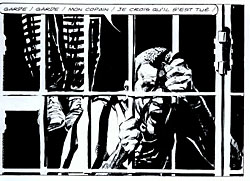>> Beyond Borders: Mondo Loco
>> Beyond Borders: Every Picture Tells A Story
More...

South America was a bad place to have certain ideologies in the '70s. Following the directives of the US-sanctioned Operation Condor, the South American military dictatorships started to eradicate all the subversive, leftist elements within their own countries. Dissidents were incarcerated, tortured and killed by the thousands. Without any form of legal procedure, people were simply dragged out of their homes, taken to a military compound and "made to disappear" without a trace.
On July 3rd 1977, a man named Héctor Germán Oesterheld was detained by the Argentinean military. He had been running from the authorities for months, since the disappearance of his four daughters. The last man who saw him alive was a survivor of the prisoner camps. He found him crying, broken, a shadow of his former self. His torturers had just shown him the pictures of his daughters; two of them were pregnant when they went missing. They were all dead, tortured to the end, their children taken from them and given for adoption to members of the same military responsible of their suffering.
Nobody saw him again. Maybe he was shot and buried in a common grave. Or, as was common at the time, thrown to the cold Atlantic waters from a plane. His crime?
Writing comic books.
 HG Oesterheld was perhaps the most important comics writer South America has ever produced, and one of the promoters of the Argentinean comics boom back in the 60s. In those days, Argentina was a blooming country. The political stability of the country, imposed by the hugely popular President Perón, helped consolidate the country's economic power and its position as the most advanced country in Latin America. Such prosperity led to the flourishing of the arts, including, of course, comics.
HG Oesterheld was perhaps the most important comics writer South America has ever produced, and one of the promoters of the Argentinean comics boom back in the 60s. In those days, Argentina was a blooming country. The political stability of the country, imposed by the hugely popular President Perón, helped consolidate the country's economic power and its position as the most advanced country in Latin America. Such prosperity led to the flourishing of the arts, including, of course, comics.
In the European tradition, most of Argentina's comics output was collected in magazines containing several different stories, some self contained, and some ongoing, with every kind of genre imaginable, from Westerns to crime to science fiction.
It was in magazines such as these that HG Oesterheld's first works were published, with series such as BULL ROCKET or SERGEANT KIRK, pencilled by CORTO MALTESE creator Hugo Pratt. But in 1957, Oesterheld decided to create his own imprint, Editorial Frontera, through which he published his own series, with the cream of the Argentinean comics scene.
Oesterheld went on to create ERNIE PIKE with Pratt; his most famous work, THE ETERNAUT, with Solano López, and SHERLOCK TIME with Alberto Breccia. But sadly, sales of the magazine were not good enough to keep Editorial Fronteta in business, and Oesterheld was forced to return to freelancing. He was soon reunited with Breccia to produce one of the most important comic works of all time: MORT CINDER.
Hailing from Uruguay, Breccia had made a big name for himself in the Argentinean industry. A fan favourite since his days on VITO NERVIO, Breccia slowly developed a drawing style heavy on the use of inks and lighting, a look that, at that time, was revolutionary.
 His experiments with the atmospherics of the spot, as opposed to the line, culminated in his work on MORT CINDER, where, "helped" by the atrocious quality of the paper and the reproduction, he was forced to turn those inconveniences into an advantage, experimenting with the use of inks not only as a descriptive tool, but as a device to create a palpable darkness. His influence can be widely seen in today's comics. Everytime Mignola holds a pencil, Breccia is there. Everytime Miller plays with the effect of window stills in his comics, Breccia is there.
His experiments with the atmospherics of the spot, as opposed to the line, culminated in his work on MORT CINDER, where, "helped" by the atrocious quality of the paper and the reproduction, he was forced to turn those inconveniences into an advantage, experimenting with the use of inks not only as a descriptive tool, but as a device to create a palpable darkness. His influence can be widely seen in today's comics. Everytime Mignola holds a pencil, Breccia is there. Everytime Miller plays with the effect of window stills in his comics, Breccia is there.
MORT CINDER is undoubtedly a masterpiece. It tells the story of a man, Ezra Winston, and his relationship with an immortal, Mort Cinder. It starts as an archetypical gothic terror tale, with a heavy Poe/Lovecraft influence, as Ezra, a London antiquary, finds a spider-like device that leaves a mark on his skin and gives him nightmares about the mysterious Mort Cinder. Soon some chilling zombie-like villains emerge, the Lead-Eyes, and there's a frantic pursuit to find the truth about Mort Cinder, leading to the emergence of the major villain of the piece, a surgeon called Dr Angus, creator of the Lead-Eyes.
Truth to be told, despite being quite a good read, the start of the series pales in comparison with what comes next, because after the 'first arc', Oesterheld changed the pace completely. He left the Victorian horror and the villains behind and focused the book around Mort Cinder and his immortality. Cinder became a man who dies and is resurrected over and over again. A witness to the extraordinary stories he spins for Ezra. And every story is a real one. A part of the story of mankind, of the cruelties, the feats and the spirit of men.
There's the story of a young soldier in the World War I, his cowardice and tragedy. A tale set in an American jail in the '30s. A couple of science fiction stories, set in Egypt and during the building of the Tower of Babel. And one crude, terribly real episode set during the slave trafficking era in Africa.
And one of the best comic stories ever written. The final stand of the 300 at Thermopylae.
 After Frank Miller's 300, you may be familiar with the story; the final stand of three hundred Spartans and some of their allies against the endless armies of the Persian Emperor. But as beautiful as it is, Frank Miller's effort can barely stand against Oesterheld and Breccia's epic.
After Frank Miller's 300, you may be familiar with the story; the final stand of three hundred Spartans and some of their allies against the endless armies of the Persian Emperor. But as beautiful as it is, Frank Miller's effort can barely stand against Oesterheld and Breccia's epic.
While 300 reads as a Western, chock full of one-liners and macho chest beating, the last 29 pages of MORT CINDER weave a tale of bravery, honour, camaraderie and death that is astonishingly vivid. Where Miller's tale is the equivalent of a Michael Bay movie, Oesterheld and Breccia's is a Scorsese epic. You can feel the blood on the pages, the laments of the dead, the terrible destiny of the Spartans, and the cruel, inevitable reality of war.
After finishing MORT CINDER, Breccia went to England to work at Fleetway, but Oesterheld stayed in Argentina, a country slowly sinking into political havoc. As the military took hold of the country's politics, Oesterheld's work began to reflect his increasingly radical political views. He started working with his daughters, who were members of the Montonero movement, an organization opposed to the dictatorship.
He wrote two comic biographies, PERON, about the now stigmatised former president of Argentina, and THE LIFE OF CHE, narrating the story of Argentinean guerrilla Ernesto "Che" Guevara. It was this work, and the second, heavy political, story of THE ETERNAUT, that sealed his fate. As one general told Oesterheld's widow, EL CHE was too beautiful a tale to be permitted. So they killed the creator.
Right now, there are no English editions of MORT CINDER. The Anglophone market, despite a growing appreciation for the talents of the likes of Eduardo Risso and Ariel Olivetti, continues to ignore a great many Argentinean productions.
Sadly, the only available editions of Oesterheld and Breccia's work are in French, Italian or Spanish, in which languages MORT CINDER has been graced with a recent re-release in hardback. Rescanned and digitally retouched to retrieve Breccia's true art - ravaged by the poor original editions - the story can now be read complete and in the best possible format. But not in English. Thus one of the most renowned books in comics history remains almost completely unknown in the English-speaking world.

This article is Ideological Freeware. The author grants permission for its reproduction and redistribution by private individuals on condition that the author and source of the article are clearly shown, no charge is made, and the whole article is reproduced intact, including this notice.


